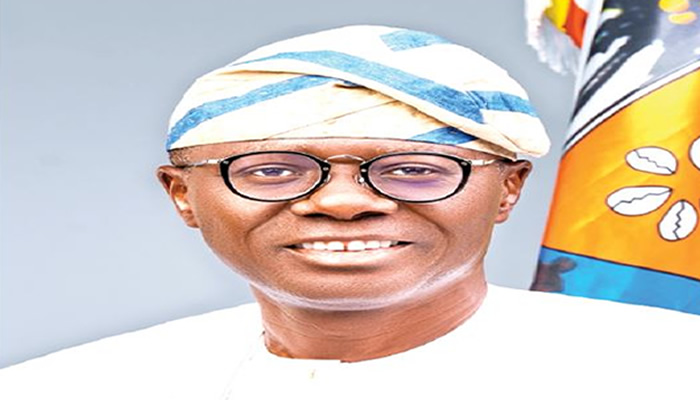
Traffic gridlock is one of the major challenges that has been plaguing Lagos metropolis for decades. With the inauguration of the Blue and Red Rail Lines, the Lagos State Government has taken a significant step towards revolutionising the city’s transport system. JUSTICE Okamga writes
Lagos State, with a population of over 21 million, was ranked as the city with the worst traffic congestion in 2023 by the Global Traffic Congestion Rankings.
The Global Traffic Congestion Rankings, which are carried out by the Traffic Index, analyse traffic congestion across cities with at least 500,000 inhabitants around the world.
A study by the Danne Institute for Research titled ‘Behavioural Causes of Traffic Congestion in Lagos’ revealed that the commercial hub loses N4tn annually to traffic congestion.
Lagos residents spend an average of 2.21 hours commuting daily, with 45 per cent enduring more than two hours.
The Lagos State Government has taken different steps to tackle the city’s incessant traffic jams. One of such efforts was the introduction of the Lagos State Traffic Management Authority.
LASMA was established on July 15, 2000, by President Bola Tinubu during his tenure as the governor of Lagos State. The aim was to transform the state’s transportation system, ensure free traffic flow, and reduce road accidents.
Despite this, the city continued to grapple with traffic gridlock, resulting in significant loss of man-hours
“I left Lagos last year for Port Harcourt; I could not cope with the stress of moving from Ikotun to Ikoyi. I could not really get a job closer to my residence until I got an offer to work in Port Harcourt. I took the offer immediately,” Mary Okojie told The Punch in a telephone chat.
After two decades of envisioning a revamped transport system, Lagos, Africa’s commercial hub, took a significant step when, on September 4, 2023, the first phase of the Lagos Mass Transit Blue Line Rail Project was officially opened to the public by Governor Babajide Sanwo-Olu, following its inauguration by former President Muhammadu Buhari on January 24, 2023.
On February 29, 2024, the state government added another metro line, Red Line Rail, which was inaugurated by President Bola Tinubu.
When completed, the 27-kilometre Blue Line rail is expected to move around 500,000 passengers daily; the first phase will move about 200,000 passengers from Marina to Mile 2.
It shares the right-of-way with the Lagos-Kano Standard Gauge Railway and utilises a diesel-powered system called Diesel Multiple Units.
The first phase of the Red Line spans from Agbado in Ogun State to the Oyingbo axis of Lagos State, covering a 37-kilometer rail line with eight stations: Agbado, Iju, Agege, Ikeja, Oshodi, Mushin, Yaba, and Oyingbo.
The project is estimated to cost $135m under the Greater Lagos Urban Transportation Project. The project will be managed by the Lagos Metropolitan Area Transport Authority.
Governor Babajide Sanwo-Olu acknowledged in 2021 that the state government secured financial support for the project through the Central Bank of Nigeria’s differentiated cash reserve requirement programme.
The Lagos State government has made significant strides in implementing an integrated transportation network, offering residents three convenient options for commuting around the state: the BRT for road transport, the Rail Mass Transit Programme for rail, and state ferries for waterways.
According to the Director of Lagos Metropolitan Area Transport Authority, Abimbola Akinajo, since its commercial launch in September, about 400,000 passengers had used the Blue Rail Line as of November 29.
So far, the system has moved close to one million passengers since its inception.
The second phase’s construction of the Blue Line, extending from Mile 2 to Okoko, is underway, with an expected completion date of 2027.
Sanwo-Olu disclosed that the combined cost of the Blue and Red Lines would surpass N100bn. The Blue Line, initially projected for completion by 2011, has faced delays primarily due to funding challenges.
Recently, the Lagos State governor was in China to finalise the purchase of six additional sets of rolling stock for both the Blue and Red Lines. These are currently being retrofitted for intra-state travel, which will boost the number of daily passenger trips.
Before the inauguration of the Red Rail Line, he emphasised on his official platform on X (former Twitter) that the LMRT Red Line “isn’t just about improving our city’s mobility; it’s about reshaping our urban landscape and setting a new pace for development.”
He reiterated that the project was a crucial part of ongoing efforts to reshape the city’s mobility, open doors to opportunities, and set a new pace for development by connecting critical points across Lagos.
The Marketing Manager at Carloha Nigeria Limited, Mathew Aje, told The PUNCH that the metro lines would help lessen the burden of the traffic experienced in the state.
He stressed the importance of effective transportation in driving economic growth.
“The Lagos Rail Line is poised to not just shorten travel times for citizens but also bolster the city’s productivity and competitive edge.
“Allocating resources to railway infrastructure serves as a lasting remedy for urban congestion. The implementation of the project mirrors international standards, positioning Lagos as a city embracing progressive approaches to sustainable urban development,” he stated.
A business owner, Onyeka Muojieke, noted, “The Lagos Rail Line is a positive step for the entire business community, particularly for businesses like mine that depend on timely deliveries. It will streamline logistics and enhance overall efficiency.”
Inauguration
President Tinubu was present for the signing of the contract for Phase 2 of the LRMT Red Line project, overseen by LAMATA DG and Chairman of the contracting firm, CCECC Nigeria Limited, Jason Zhang.
Tinubu joined Sanwo-Olu, the Chinese Ambassador to Nigeria, Cui Jianchun, and others on an inaugural train ride from Ikeja Train Station to Agege Station, accompanied by Lagos State Deputy Governor, Dr Obafemi Hamzat.
Addressing the gathering at the Ikeja train station, the President urged the Minister of Transportation, Senator Sa’idu Alkali, to ensure strengthened collaboration among governments at all levels for reliable, efficient, and affordable transportation systems.
In response, the minister expressed the Federal Government’s readiness to collaborate with other state governments and the private sector to enhance the rail transportation system for the ease of movement of people, goods, and economic development.
Tinubu characterised the project as the realisation of a dream and the culmination of years of hard work and dedication by successive governments.
”I am very happy indeed that today is a day to remember in Nigeria’s infrastructural history, particularly Lagos, the centre of excellence. Today is evidence that it is good to dream, and it is a serious validation of democracy as a form of government of the people, by the people, and for the people.
”25 years ago, I was elected to lead Nigeria’s most populous state. From the very beginning, my team and I toiled day and night with a very bare cupboard amidst pervasive deficiency to implement a developmental vision that would transform Lagos into an economic powerhouse. Today, we are realizing that dream.
”The momentum of greatness we kicked off a quarter of a century ago has become unstoppable progress. It is not illegal to dream big. Just stay focused and make development a central focus,’’ he said.
According to Sanwo-Olu, the state has a Strategic Transport Master Plan that outlines what that integrated rail system should look like six rail lines, one monorail, 14 bus rapid transit corridors, over 20 water routes, and a vast network of major and inner roads.
“In the grand tapestry of our development agenda, we are advancing a series of visionary legacy initiatives,” he stated.
Safety concerns
Traders and pedestrians crowding near train tracks in Lagos pose safety concerns due to their disregard for walkways and footbridges.
Addressing these challenges is crucial to enhancing safety and security for both traders and pedestrians in Lagos.
The governor acknowledged those concerns and cautioned traders and residents to avoid the tracks, as there would be continued enforcement to ensure the tracks remained clear.
“The challenge we have is the pedestrian interference on the rail track and unapproved activities seen along the corridor. We will continue with the enforcement we started against illegal use of the rail corridor. We are in talks with the NRC to reinforce the train route with physical barriers to limit pedestrian interference.”
“Because once the intra train starts, it is not every two hours or three hours; it’s going to be fairly regular, 10 minutes, 15 minutes, and we don’t want them to feel comfortable that they have to stay on track. It’s not a place for people to stay.
“That is the major challenge; we have reduced it considerably in the last two months, and we will not stop,” Sanwo-Olu stated.
The Lagos State Emergency Management Agency signed a Memorandum of Understanding with a private firm, First Metro Infrastructure Limited, to combat any emergency case that may occur along the Red Line rail.
The Permanent Secretary of LASEMA, Femi Oke-Osanyintolu, assured residents of adequate security for lives and property within and outside the corridor. He also cautioned against flouting any laid-down rules or regulations regarding train engagement.
A joint committee was established by LASEMA, comprising members from the FMIL team. This team promptly initiated action and conducted a risk analysis from Agbado Station to Oyingbo Station.
At each station, a Geographic Information System would be deployed to assess the distance between stations and routes to emergency centres such as hospitals, fire services, and LASEMA, the coordinating agency.
“And the good thing is, if we have an emergency, we can easily kick-start our response. And the response will not only be effective; it will also be efficient”, Oke-Osanyintolu assured.
“We have done everything humanly possible to ensure their safety. We’ve done what we call risk analysis, or resource mapping. When residents abide by the rules and regulations, we can assure them of their safety, and we can assure them of their clean business continuity.
“To ensure that the passengers on the red line rail and metro rail routes are safe in terms of infrastructure and terms of their safety on the trains, both on and off the train,” he urged.
The state has constructed 10 vehicular overpasses and pedestrian bridges, separating train traffic from vehicular and pedestrian flows.
This will also help to ensure the smooth operation of the rail line and safety for commuters.
Green and Purple Lines
When fully developed, there will be a total of six lines on the Lagos Rail Mass Transit System. The state has started preliminary work on the next two: the green and purple lines.
In December, that state said it had commenced talks with private investors for feasibility studies of the construction of the green and purple rail line systems to be completed in three and a half years.
The Green Line is a 71.49-kilometre route from Marina to the Lekki Free Zone, one of the fastest-growing industrial areas on the continent today and where the new Lagos International Airport will be located.
The Purple Line is a 54.35-kilometre line from the Redemption Camp to Ojo, near Lagos State University. The final two lines will be the orange and yellow lines.
However, contract signing to kick off the construction had yet to take place.





